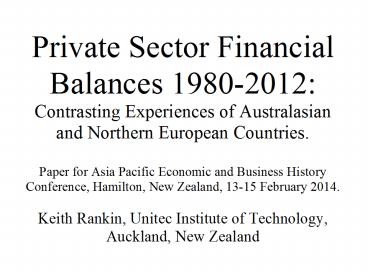Debt - PowerPoint PPT Presentation
Title:
Debt
Description:
Debt & Deficits ... Aust-NZ vs. Nordics Similar profiles in 1980s common themes pre-1980s financial ... after Asian 1997/98 crisis Australasia especially New Zealand ... – PowerPoint PPT presentation
Number of Views:168
Avg rating:3.0/5.0
Title: Debt
1
(No Transcript)
2
Debt Deficits Credit Surpluses
- Debt and Credit cumulative stock variables
- relationship
- debtors and creditors "joined at the hip"
(Atwood) - debt topic of discomfort
- allegedly greater discomfort in some cultures
- eg Germany versus English-speaking countries
- debt topic of confusion
- country's debt national debt public debt
- Deficits (D) and Surpluses (S) flow variables
- accounting identity total surpluses total
deficits (SD) - S (-D) 0 sum of all sectoral balances
equals zero - a deficit is an addition to debt or a reduction
of credit
3
Sectors
- Global Economy
- governments (public) and others (private)
- private includes corporate and household
- two sectors one degree of freedom
- private sector balance negative of government
surpluses - global government sector almost always in deficit
- see next slide for 2001 to 2010 global balances
- interpretation
- economists commonly think of 'crowding out'
- implies autonomous government accommodating
private sector - untenable interpretation post 2008
- governments have 'intelligence' to accommodate
- called counter-cyclical fiscal policy
4
Global Intersectoral Balances
5
Sectors
- National Economy
- Foreign sector Government sector Private sector
- two degrees of freedom
- foreign balance is negative of current account
balance - example profiles Japan, USA, UK and Germany
- possible for some countries to have positive G
and P - but not all !
- such, if long term, would be an ideal
'mercantilist' position - Australasia New Zealand and Australia
- commonly classed as debtor-deficit economies,
like USA - Nordic Countries Sweden, Norway, Denmark,
Finland, Iceland
6
Japan
7
United States
8
United Kingdom
9
Germany
10
Profiles Aust-NZ vs. Nordics
- Similar profiles in 1980s
- common themes
- pre-1980s financial 'repression'
- rapid finance-sector liberalisation
- Australia least rapid liberaliser
- financial liberalisation
- rapid emergence of negative private-sector
balances - government appears to have crowded out private
sector in New Zealand in mid-1980s - substantial financial flow to these private
sectors after 1987 in countries with lesser
sharemarket crashes banking crises c.1990 - Contrasting profiles after about 1992
11
Australia
12
Sweden
13
Denmark
14
Norway
15
New Zealand
16
Finland
17
Iceland
18
Iceland
19
Extended Profiles since 1992
- Nordic Countries
- especially Sweden, Denmark, Finland
- mercantilist 'creditor-surplus' profile
- Sweden
- banks rescued in government equity bail-outs
- governments and private sector pursue austerity
- strategies accommodated by foreign sector
- like Malaysia (especially) after Asian 1997/98
crisis - Australasia
- especially New Zealand
- debtor-deficit private-sector profile
- no sign yet of Scandinavian-style crises despite
profile - accommodates foreign surpluses via monetary-policy
20
Malaysia
21
Global Financial Crisis 2008-10
- "Balance-sheet recession" (Koo)
- autonomous private sector surpluses in corporate
and household sectors, through debt-reduction
andopen-mouth policy accentuating precautionary
saving - fiscal policy, not zero interest rates,
accommodate - accentuated post-'92 pattern in creditor-surplus
countries - reversal in most debtor-deficit economies, incl.
Aust.-NZ - Post GFC echoes of 1920s?
- return to profiles of last 20 years creates
short-run global stabilisation but accentuates
long-run financial imbalance - fewer sectors or sub-sectors willing/able to
accommodate increased global preference for
private surplus balances































